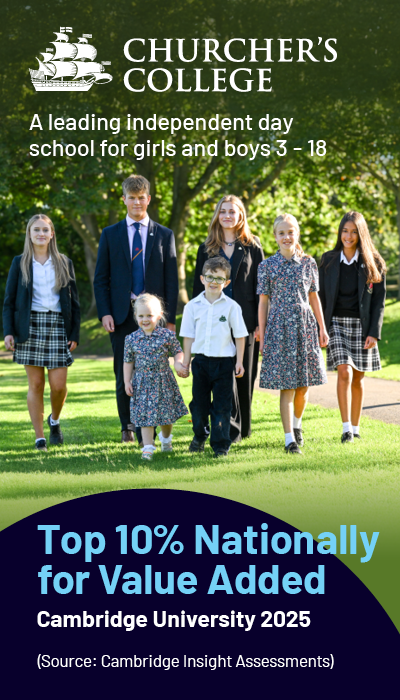A Head for 25 years, Mike Piercy is now an educational consultant and school governor. Here, he advises on choosing the right fit for your child
I confess. I admit it. I failed the 11+. Once upon a time all eleven-year-olds took the test. My recollection is vague. We weren’t told what we were about to do, just plonked into a room with papers thrust in front of us, ordered to silence under threat of death (or worse) and told to get on with it. How times have changed.
More recently I have seen children, pale and tearful, as they emerge from the 11+ exam. In one instance, a boy whose tie had been relentlessly gnawed, chewed as the cud, was a quivering wreck. Such is the pressure and anxiety the 11+ can induce. In his case the expectation was unrealistic; the hurdle too high. For months, and sometimes years, prior a tutor will have been enlisted – a happy hour after school every week, winter and summer holiday, rain, wind or shine.
To those who have cleared the bar this year: congratulations and well done. To those who tried but have not crossed the desired threshold, I hope what follows provides some solace. There will inevitably be some who are disappointed.
My next serious encounter with exams was the 13+ Common Entrance exam to independent senior schools. My parents worked in Africa and my father’s firm provided boarding school education for his two sons. It is perhaps worth pointing out that not all those who attend independent schools are wealthy. I didn’t do very well in the exam but just sufficient to gain entry to my senior school.
As a lateral point, in the unlikely event of my having any influence in government or the DfE I would lobby for the return of the Middle School model with transfer at 13 and not 11. Those two years make an enormous difference: socially, emotionally and cognitively.
Some years ago, talking to the Head of a very academic grammar school, I asked of the greatest challenges he faced in his school. I had expected funding, facilities or finding the best teachers; thus his answer surprised. On reflection, though, it made absolute sense. His biggest concern was those children who had been tutored within an inch of their lives, slaving over hot reasoning tests, thus successfully gaining entry to his school. Too many then failed to thrive, not meeting the academic expectations. Self-esteem plummeted, poor behaviour sometimes followed, with fragile mental health the root cause. The ambition to gain successful entry to high-achieving, academic schools is rarely the ambition of the child. It can come under the rather clichéd mantra: be careful what you wish for. I’m not knocking ambition – far from it. I’m encouraging realistic ambition within the character, capability and maturity of each individual child. The answer lies in choosing the right school, not driven solely by parental ambition, possibly living vicariously through their children. There’s a lot to recommend a child being around the middle of the academic range, performing better than some, while aspiring to the higher achievers. So, what should you look for in a potential school? Exam results are but one benchmark. Many schools have a value added quotient which reveals far more: ability benchmarked on entry, then measured against national exam results. Some local authorities conduct wellbeing surveys in their schools: does this data exist for your shortlist? Surely wellbeing is all-pervading? Then there is the breadth of education. Does the school have a relevant, strong reputation or specialism: sport, drama, music, performing arts, technology? Returning to academic selection – for 11+ grammar or for an independent school. If you feel your child is suited, has the resilience for preparation, for testing and, importantly, you have the encouragement of the current school: go ahead.
If you are confident in coaching the components of the tests – great. If not, consider specialist support.
This could be tutoring. The ‘best’ tutors will be overbooked in this burgeoning industry. Are we more competitive or is there greater competition for those selective schools, grammar or independent, I wonder? Local recommendation can be helpful but you can also search via the professional organisation ‘The Tutors’ Association’. For 11+, for independent school Y6 pre-assessment, Atom Learning is an excellent online, adaptive platform (though it does come at a cost) and there are other apps available. The Bond books (and online) are popular.
Whichever preparation route you choose, take care to track progress. Year 5 children will not always choose the toughest route. With Atom, for example, the child can choose which component of the testing to work on: reasoning, verbal and non-verbal, maths or English. You can – should – monitor progress across the components. For each session perhaps start with the least favourite (most difficult) topic before moving on to something more appealing. The pool table analogy: go for the tricky shot to open up the play.
There is no substitute for visiting the potential school. Exam results, league tables, websites, reviews and anecdotal dinner party chat are all informative. Paramount, however, is ‘feel’. Ambience and atmosphere cannot be measured; they can only be felt.
Sometimes an Open Day visit gives an initial sense with the additional benefit of anonymity. An individual, personal visit provides the opportunity to dig deeper. Do not be afraid to ask questions – no matter how searching – striving to find the best match of school and your child. What differentiates you, School A, from School B? How are pastoral care and wellbeing supported and monitored? What are the options for GCSE and A Level (or IB)? Ask to see leavers’ destinations – if not already provided on the website.
When students are the guides one of my favourite questions is, ‘How has the school helped you grow – in character, confidence and performance?’ Be prepared: bring your own bespoke questions.
There’s no denying it can be a nervy, sometimes bewildering process – particularly when travelling the road for the first time. In my experience, however, while there may be disappointments along the way, almost exclusively children end up at the right school for them. The disaffection and disappointment is often ours, as parents. If your child lands a place at a school about which you have some reservations, work hard on building a relationship with the teacher or tutor who has direct care for your child – keep the lines of communication open.
Then, for some schools, there is the interview – a whole different ball game which featured in last month’s issue. The trick is for candidates to be themselves. Admissions staff and teachers can spot a robotic, rehearsed, rote answer a mile off and, after all, everyone wishes for the same thing – the right school for the right child. A good fit.
Mike’s book, Careering, is available now with troubador.co.uk. You can contact Mike at
mikepiercy@hotmail.com with your education-related queries.
You may also like
Thinking of 2026
There’s much to be gleaned from the Harry Potter book series when it comes to language and emotional intelligence, explains former headteacher Mike Piercy How many of us watched a Harry Potter film over the Christmas period? Our children grew...
Myth Busters
We hear from ACS International School Cobham as the school celebrates its 50th anniversary, reflecting on how far it has come and setting the record straight on a few common misconceptions along the way From its origins as a school...
Added Value
Some vital aspects of education are not easy to measure, says former headteacher Mike Piercy Are we stumbling, blundering – even thundering – into a Wildean world? Oscar Wilde defined a cynic as someone ‘who knows the price of everything...













